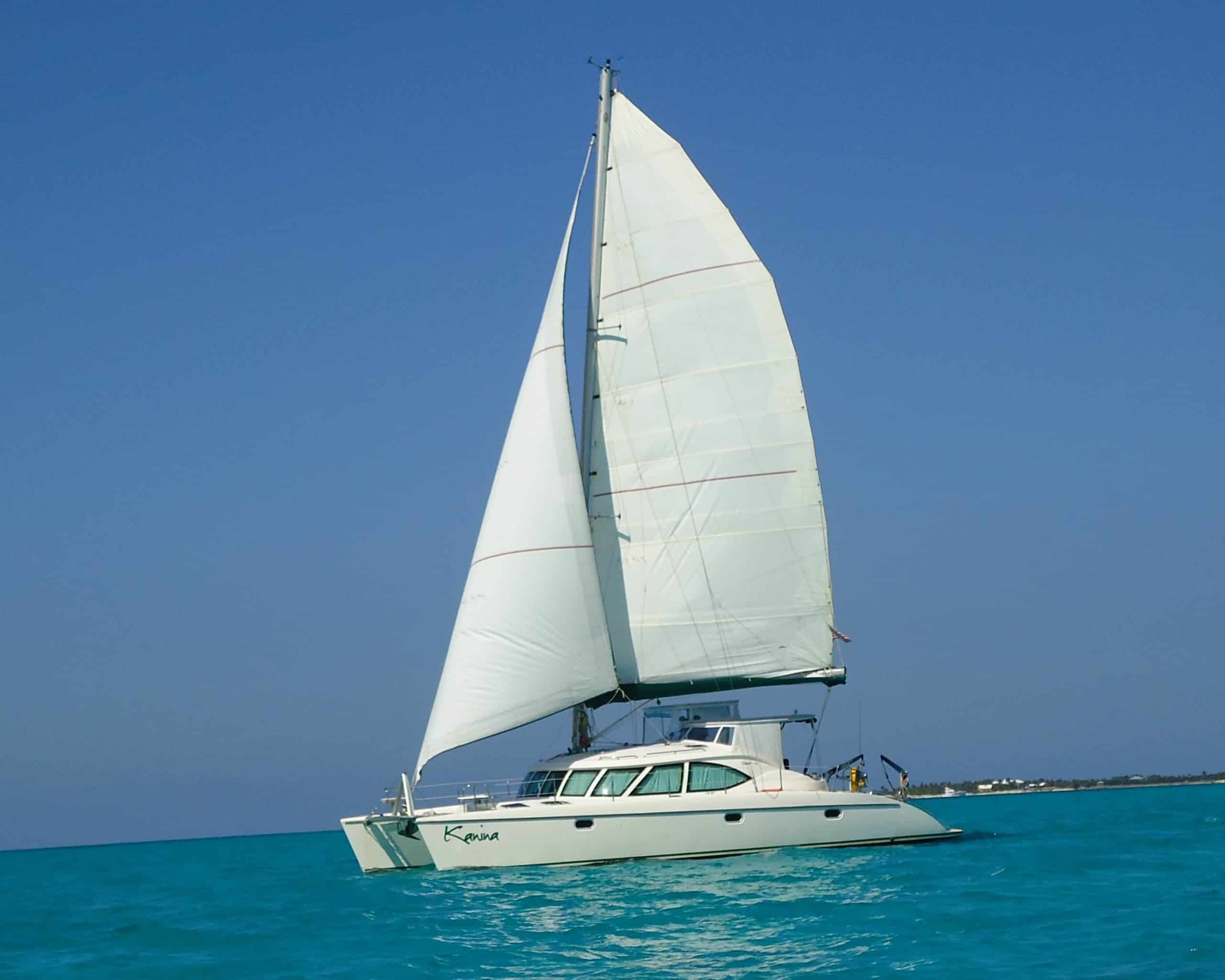 We have been attending boatshows for more than 14 years, representing a variety of boat builders, from South Africa, South America, Thailand, China and the USA and we always get this one question: “What is the perfect catamaran?”. Every manufacturer would have you believe that they have THE perfect catamaran and even though some come close, there simply is no such thing. Just like with a house, you will have to compromise or customize and even then, one always has to give up one thing to gain another. While choosing the right catamaran is a very personal choice, you can avoid some serious blunders by following these ten tips as a guideline.
We have been attending boatshows for more than 14 years, representing a variety of boat builders, from South Africa, South America, Thailand, China and the USA and we always get this one question: “What is the perfect catamaran?”. Every manufacturer would have you believe that they have THE perfect catamaran and even though some come close, there simply is no such thing. Just like with a house, you will have to compromise or customize and even then, one always has to give up one thing to gain another. While choosing the right catamaran is a very personal choice, you can avoid some serious blunders by following these ten tips as a guideline.
Define How You Will Be Using Your Catamaran
Be realistic about your sailing plans. Is it your intent to live aboard, do mostly coastal cruising and spend most of your time at a marina or at anchor or are you planning to do long ocean crossings and perhaps sail around the world? A spacious charter catamaran like Lagoon or Leopard may be a great luxury live aboard boat with all the goodies like icemaker, watermaker, airconditioner and luxurious finishes, but it may be slower underway making you regret that choice if cruising long distances.
If you primarily sail on weekends or short trips, a rugged blue water cruiser like Catana or Discovery, with big rig and sails, may be more than you need. So be clear about what you intend to do with the catamaran and hone in on what is important to you right now. Why own and keep up a new expensive offshore catamaran when a smaller or pre-owned catamaran will do the job just fine
Comfort Or Performance
Most modern catamarans are beautifully appointed with freezers, fridges, water makers, corian counter tops and heavy wood finishes primarily targeting the charter market. While that is gorgeous, all that weight will no doubt influence the performance of the catamaran because the more weight that’s added to a catamaran, the more the sailing characteristics of the catamaran is altered. With the catamaran sitting lower in the water with less bridgedeck clearance, weighed down with all the extra gear, the slamming and wallowing could be very uncomfortable in heavy seas and slow it down significantly. Performance catamarans like Catana or Outremer are built for speed with narrower hulls, lighter and high tech materials and of course cost a lot more than a regular catamaran like Lagoon or Fountaine Pajot which is purpose built for the cruising sailor. Speed is not as much of a factor. If crossing oceans safely and comfortably is what you want to do, be mindful of weight and design. If you are looking for a comfy spacious catamaran at anchor, go for wider hulls and open space. Application is key!
Consider Chartering Your Boat If Your Sailing Time Is Limited
If you cannot afford the time it takes to sail and maintain your catamaran on a regular basis, it makes sense to place your catamaran in a charter management program like Dream Yacht Charter. There are many other great catamaran charter programs available and could potentially make financial sense for owners who are getting ready to live aboard but need a few more years to get their affairs in order. That way one can sail the catamaran as often as possible, while getting an income from charter. The revenue that is generated from charter far outweighs the wear and tear that occurs during the charter phase. When ready to embark on your adventure, you can do the phase-out with the charter company, do the annual haulout, and add all the toys like watermaker, SSB radio etc.
Do A “Try Before You Buy” Form A Charter Company
Some charter companies offer programs like “try before you buy” to accommodate prospective buyers. This is a great way to “seatrial” a catamaran. You can charter the catamaran of your choice, stay on it and sail it for a few days and figure out if this is indeed the catamaran for you. Living on a catamaran will give you a pretty good idea what you like or do not like about that particular catamaran and whether the things you dislike will be a deal breaker. Usually in this case the charter company will refund you the price of the charter if you buy the boat which is a great way to “learn” the catamaran.
Seatrial The Catamaran In All Conditions When Buying A Pre-Owned Catamaran
Try and sail the catamaran in a breeze and some wave action to adequately measure the performance of the boat. It is simply not always possible and in this case the quality of your broker and his/her knowledge will have to be your guide. Even so, you will want to sail the catamaran to get the “feel” of it, how it handles, how the instruments are placed, whether you can easily reef sails and if the bridge deck clearance is adequate.
Get Your Own Independent Surveyor When Buying A Pre-Owned Catamaran
Most buyers are not experienced enough to make an informed evaluation of the condition of the catamaran on their own. Having a marine survey done by a qualified and accredited marine surveyor is buying peace of mind. A marine survey is a detailed inspection of a boat by an accredited marine surveyor to determine its current condition and seaworthiness and in particular to determine if the vessel is safe to operate in conditions for which it was designed. It will also give you a good insight into the maintenance aspect as well as the repairs to be done or likely to be required in the near future.
Project Boats Can Break The Bank
If you are inclined to buy a project boat because you have the skills and the time to work on the project yourself, be careful to not under estimate the time and money it will take to bring the catamaran up to the standard you would like and make sure that it is a fundamentally good design. The survey should give you a better idea of exactly what you are getting into with your boat purchase and help you learn what will be necessary to maintain the vessel in the future. Keep in mind that if your project boat looks like a project boat, the resale value may be significantly less, so be sure to do the best possible finishing, rewiring, plumbing etc. Many owners get discouraged after sometimes years of working on this project and finally give up. Unfortuanately, it is almost certain that you will probably not get your money back on the unfinished project, so be sure of the time you need to finish the project.
Rule Of Thumb: All Catamarans Cost The Same
You have two choices when purchasing a catamaran:
- You can either pay top dollar for a nice new shiny catamaran off the shelf with all the options or a perfectly maintained pre-owned catamaran with all the options
- Alternatively you can buy a fixer upper at a bargain basement price and have the impovements done by contractors.
However, by the time you bring the cat up to look exactly like the well maintained or new shiny cat, it will most likely have cost the same. The only caveat to this rule of thumb is if you have the technical skills to do the improvements yourself in which case you may be able to bring the cost down considerably.
Custom Catamarans Can Be Costly
We have been involved in some custom builds and it almost always takes longer and turns out more expensive than originally estimated. This is mostly because building molds are expensive and if used only once for your boat, you have to carry the cost of the customization. Also, because it is custom, owners tend to make several changes as the project progresses which takes time and money to implement. We advise that owners for custom boats add at least 20% more time and money to a project like this. The owner should also be aware that he most likely will not get back what he put into the project when the time comes to sell because the catamaran is not widely known.
Be Mindful Of Your Own Capabilities And Skills
We all tend to think that bigger is better, however when it comes to sailing a catamaran, or any boat for that matter, one should keep in mind one’s physical capabilities and sailing skills. Sailing skills can be learned as we have proven at our seaschool with total novices who have become ocean voyagers. It is best to buy a catamaran for you and your sailing partner in the 40-50ft range that is rigged for single handing with electric winches and a self-tacking jib if possible. This will give you more flexibility and control. One caveat though, South African yachtsman Geoff Hilton-Barber is blind and he managed single handedly to do an ocean crossing, so don’t ever let a disability stop you!
 While we can use these ten tips in general to make an informed decision, we should be mindful that there are no hard and fast rules. The purchase of a cruising yacht is probably one of the biggest investments the buyer will make in thier lifetime so it makes complete sense to ensure that they have the very best information going into the transaction and remember, it is as much an emotional decision as anything and one has to guard against getting too invested. Work with a broker such as Catamaran Guru, members of the International Yacht Brokers’ Association.
While we can use these ten tips in general to make an informed decision, we should be mindful that there are no hard and fast rules. The purchase of a cruising yacht is probably one of the biggest investments the buyer will make in thier lifetime so it makes complete sense to ensure that they have the very best information going into the transaction and remember, it is as much an emotional decision as anything and one has to guard against getting too invested. Work with a broker such as Catamaran Guru, members of the International Yacht Brokers’ Association.





